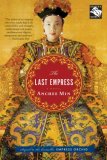Summary | Excerpt | Reviews | Beyond the Book | Readalikes | Genres & Themes | Author Bio

Critics' Opinion:
Readers' Opinion:
First Published:
Mar 2007, 320 pages
Paperback:
Apr 2008, 336 pages
 Book Reviewed by:
Book Reviewed by:
BookBrowse Review Team
Buy This Book
I often wondered what kept General Tseng Kuo-fan from rebelling.
A coup wouldn’t be hard — he had the money and the army. I used to think
that it was just a matter of time. “Enough is enough,” I could imagine Tseng
saying one day, and my son would be out of luck.
I signed my name in fine calligraphy. Above it I put my signature
stamp in red ink. I had stone stamps of different sizes and shapes. Besides
the stamp, which was given to me by my husband, the rest described my
titles: “Empress of China,” “Empress of Holy Kindness,” “Empress of the
Western Palace.” “Empress Tzu Hsi” was the one I used most often. These
stamps were important to collectors. To make the artwork easier to sell later,
I would leave out the name in my dedication, unless otherwise requested.
Yesterday An-te-hai reported that my paintings had risen in value.
The news brought me little joy. I would much rather spend time with Tung
Chih than feel forced to paint.
Anyone who examined my paintings could see their flaws. My
brushstrokes showed that I lacked practice, if not talent. My handling of ink
revealed that I was merely a beginner. The nature of rice-paper painting
allowed no mistakes, which meant that I could be spending hours on a piece,
work late into the night, and one lousy stroke would ruin the entire thing.
After months of working on my own, I hired an artist-tutor whose job was to
cover my flaws.
Landscapes and flowers were my subjects. I also painted birds,
usually in pairs. I would place them in the center of the frame. They would
perch on the same or separate branches, as if having a chat. In vertical
compositions, one bird would sit on the top branch and look down, and the
other would be on the bottom branch looking up.
I spent the most time on feathers. Pink, orange and lime green
were my favorite feather colors. The tone was always warm and cheerful.
Ante- hai suggested that I paint peonies, lotus blossoms and
chrysanthemums. He said that I was good at painting these, but I knew he
meant they were easier to sell.
A tip I learned from my artist-tutor was that the stamps could be
used to cover flaws. Since I had fl aws everywhere, I applied a number of
stamps to each painting. When I was dissatisfied and wanted to start over
again An-te-hai reminded me that quantity should be my objective. He helped
to make the stampings look interesting. When I felt there was nothing I could
do to save a work, my tutor would take over.
My tutor worked mostly on backgrounds. She would add leaves
and branches to cover my bad parts and would add accents to my birds and
flowers. One would think that her fi ne strokes would make mine an
embarrassment, but she applied her skill only to “harmonize the music.” Her
artistry saved my worst paintings. It was amusing to watch her painstakingly
try to match my amateur strokes.
My mind often wandered to my son while I was painting. At night
it became difficult to concentrate. I would imagine Tung Chih’s face as he lay
in bed and wonder what he was dreaming. When my desire to be with him
became desperate, I would put down my brush and run to Tung Chih’s
palace, four courtyards from my own. Too impatient to wait for An-te-hai to
light the lanterns, I would rush through the darkness, bumping and bruising
myself on walls and arches until I arrived at my child’s bedside. There beside
my sleeping son, I would check his breathing and stroke his head with my
ink-stained hand. When the servant lit the candles I would take one and hold
it close to my son’s face. My eyes would trace his lovely forehead, eyelids,
nose and lips. I would bend over and kiss him. My eyes would grow moist as
I saw his father’s likeness. I would remember when Emperor Hsien Feng and
I were in love. My favorite moment was still the time when I sweetly tortured
him by demanding that he memorize my name. I wouldn’t leave Tung Chih
until An-te-hai found me, his long procession of eunuchs trailing behind him,
each carrying a giant red lantern.
Copyright © 2007 by Anchee Min. Reprinted by permission of Houghton Mifflin Company.





The Funeral Cryer by Wenyan Lu
Debut novelist Wenyan Lu brings us this witty yet profound story about one woman's midlife reawakening in contemporary rural China.
Your guide toexceptional books
BookBrowse seeks out and recommends the best in contemporary fiction and nonfiction—books that not only engage and entertain but also deepen our understanding of ourselves and the world around us.